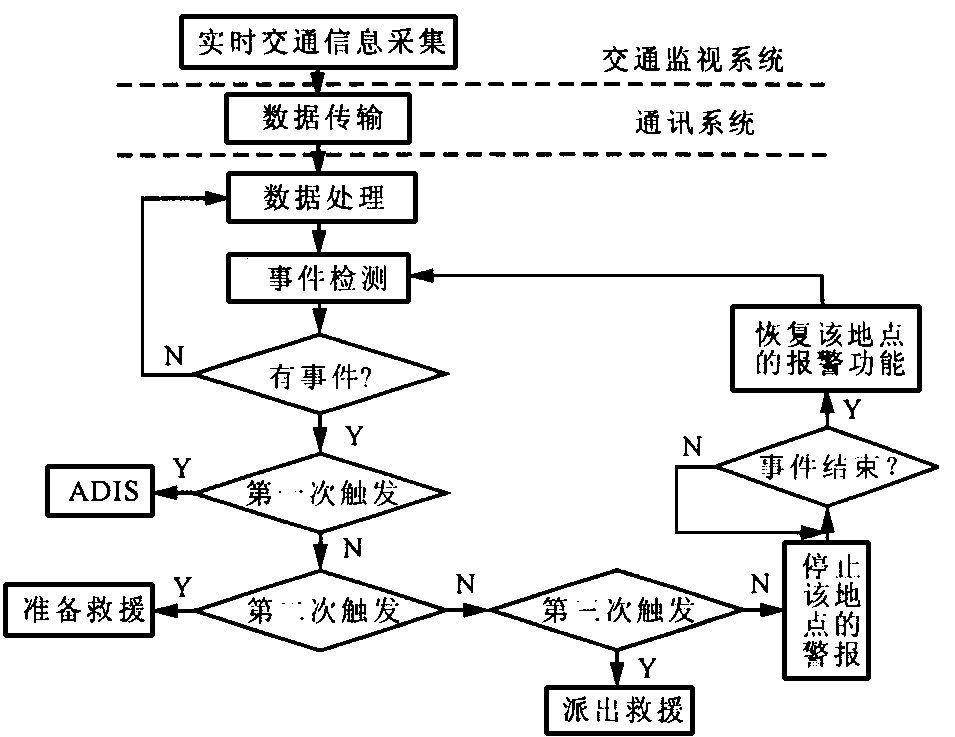Design of Freeway Automatic Incident Detection System and Algorithm
Article Text (Baidu Translation)
-
摘要: 据估计发达国家高速公路中60 %~ 70 %的延误是由交通事件引起的, 而交通事件的早期检测与及早分流可以使由其引起的延误大幅度降低。自2 0世纪60年代开始的交通事件自动检测(AID) 系统的目标一直是协助交通管理部门处理交通事件。尽管已开发并投入使用了多个AID系统, 但是居高不下的误警率(FAR) 和令人失望的检测效果, 让一些交通管理者不得不放弃它的使用。为了提高AID系统的可靠性和实用性, 提出了一种具有三级报警制度的高速公路交通事件自动检测系统框架, 并以人工神经网络技术为依托, 设计了基于单个检测设施的AID算法。模拟计算表明, 基于单个路段交通流参数标定的模型可以应用于其它路段交通事件的检测。在检测率(DR)、误警率(FAR) 和平均检测时间(MTTD) 方面都优于目标方法, 而且由于每个检测器站只需安装一个检测器, 也降低了高速公路事件管理系统的建设成本。Abstract: As high as 60% to 70% of the traffic delay experienced by motorists in developed countrics is attributed to traffic incident. A substantial reduction in this delay can be achieved by early detection of the incidents that cause it and prompt response to divert the traffic in the upstream flow. Since the late 60s of 21th, Automatic Incident Detection (AID) systems have been developed and implemented to help traffic management authorities. However, high false alarm rates and low poor performance of the adopted AID system have caused some authorities to abandon them. To enhance the reliability, transferability and economization of AID system, a framework for freeway AID system with three grade alarm policy is put forword, and an AID algorithm based on the Artificial Neural Networks (ANN) technology that only need single detector is designed. It was proved by simulated data that the model built on one segment can be utilized to other segments, and all three measurements (DR, FAR and MTTD) are superior to the objective algorithm. Furthermore, the total cost of freeway incident management system can be reduced due to only single detector is needed for one detector station.
-
表 1 目标算法的事件检测效果
模型 一级报警 二级报警 三级报警 DR1 MTTD1 FAR1 DR2 MTTD2 FAR2 DR3 MTTD3 FAR3 模型1 88.99 2.95 0.32 86.33 3.17 0.23 79.66 3.62 0.06 模型2 97.55 2.31 0.25 97.99 2.42 0.22 93.12 3.09 0.03 模型3 89.99 2.45 0.21 91.33 2.64 0.25 81.33 3.17 0.03 模型4 95.99 2.58 0.18 95.66 2.90 0.18 92.33 3.39 0.02 模型5 90.66 2.58 0.15 92.66 2.87 0.10 83.33 3.50 0.01 平均 92.64 2.57 0.22 92.79 2.80 0.20 85.95 3.36 0.03 表 2 本算法的事件检测效果
模型 一级报警 二级报警 三级报警 DR1 MTTD1 FAR1 DR2 MTTD2 FAR2 DR3 MTTD3 FAR3 模型1 98.33 2.21 0.39 98.99 1.96 0.59 93.99 3.00 0.03 模型2 98.99 2.18 0.32 98.99 2.15 0.55 94.66 3.05 0.03 模型3 98.33 2.07 0.44 98.66 1.99 0.42 91.33 2.91 0.03 模型4 96.99 2.60 0.17 99.00 2.69 0.25 92.99 3.41 0.02 模型5 97.99 2.57 0.12 97.99 2.66 0.11 90.33 3.43 0.02 平均 98.13 2.33 0.29 98.73 2.29 0.38 92.63 3.16 0.03 -
[1] LINDLEY J A. Quantification of urban freeway congestion and analysis of remedial measures[R]. Federal Highway Administration, Washington, DC., 1986. [2] BALKE K N, ULLMAN G L. Method for selecting among alternative incident detection strategies[R]. Texas Transportation Institute, 1993. [3] ROPER D H. Freeway incident management. NCHRP synthesis of highway practice 156[R]. National Research Council, Washington DC, 1990. [4] RAZAVI A. A survey of automatic incident detection systems[R]. Prepared for Province of British Columbia Ministry of Transportation and Highways, Victoria, BC, Canada, 1995. [5] RAZAVI A. Development of a new automatic incident detection system for freeway using a B1-classifier approach[D]. Ph. D. Thesis at the University of British Columbia, Canada, 1998. [6] ABDULHAI B, RITCHIE S G. Enhancing the universality and transferability of freeway incident detection using a bayesian based neural network[R]. Transportation Research Part C, 1999.261-280. [7] 刘伟铭. 高速公路系统控制方法[M]. 北京: 人民交通出版社, 1998. -





 下载:
下载:


